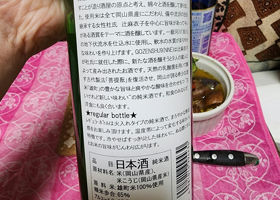



あいはらリオ
After aging, the rich flavor derived from Omachi rice and the characteristic acidity of "Bodimoto" stand out in this clean, umami-guchi type Junmai sake.
We recommend serving with fatty seasonal sashimi, eel, and hard cheeses (Mimolette Conte).
Serve well chilled on its own or warmed.
The oldest sake brewing method in Japan, the "Bodimoto" method, is used.
The "Bodimoto" method is said to be the origin of various sake brewing methods.
The characteristic feature of this process is "soyashi water," which is made by generating natural lactic acid bacteria in the water in which rice is added.
This water is added at the beginning of the "Moto" making process,
This water is added at the beginning of the "Moto" making process to promote alcohol fermentation while suppressing bacteria,
This makes it possible to produce safe and clean sake even in the summer.
NINE" challenges the roots of sake with a process that is rare in Japan, and continues to refine and innovate as never before.
It is just smooth! The moment you put it in your mouth, ((**))gentleness spreads!
The sharp taste of sake has been refined to the utmost limit!
I enjoy it cold, but it might be better to drink it at room temperature or lukewarm for a better taste of the rice!
I want to enjoy the change of temperature as well 🎶Thank you for such a sake today🙏!
Japanese>English
ポンちゃん
Rio, also here 😊.
I'd like to take the time to taste the Bodo sake once I get it ❣️ I'll remember to change the temperature if I can get it 😆👍
Japanese>English
あいはらリオ
Pon-chan.
It was very delicious!
It has a white wine-like mouthfeel, but the rice flavor comes through afterwards!
I recommend the process from cold to room temperature!
Japanese>English